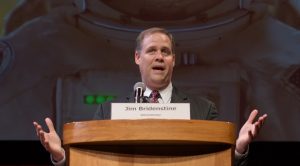
NASA Administrator Jim Bridenstine was on hand recently for the third meeting of the National Space Council.
It was his first to attend since becoming the newest administrator after leaving Congress where he represented Oklahoma’s 1st U.S. House District. Bridenstine also gave an update on NASA activities.
“The architecture that we’re building now is entirely different than any architecture that we’ve ever built before in an effort to get to the moon,” said Bridenstine in briefing the council. “And the reason is, we have more capabilities now than we’ve ever had as a nation.”
The Space Council was revived last year under the leadership of Vice President Mike Pence who was on hand for the recent meeting.
In connection with the Council, President Trump also announced his plan to create a “Space Force” that would be a separate force of the U.S. military. It would be the 6th division of the U.S. military.
Why the need for such a force? President Trump said it stems from national security concerns over renewed interest in space by China and Russia. He had previously referred to space as the “new warfighting domain.”
In recent weeks, Bridenstine has spoken of the Space Policy Directive which formally directs NASA to return humans to the moon. Since the President signed the directive in December, NASA has developed an “Exploration Campaign.”
“Our objective is to make sure that, over the long term, we’re going to have a human presence at the moon,” said Bridenstine in a recent speech. “We want a sustainable, long-term presence at the moon.”
A second Space Policy Directive signed in May addresses commercial space regulatory reforms. There is also the issue still to be decided which government agency should be put in control of launch licensing.
But Bridenstine did not take a stance on which agency.
“There might be some disagreement between the House and the Senate on that. I’m not going to weigh in on that, at least at this juncture,” he stated recently. “The important thing to recognize is that it needs to be done. that’s the key.”
Then there is the issue of “orbital debris” which Bridenstine calls a “very real challenge.”
“If we don’t start now putting together the right process to do space situational awareness and space traffic management, this is not going to go well,” said Bridenstine.






